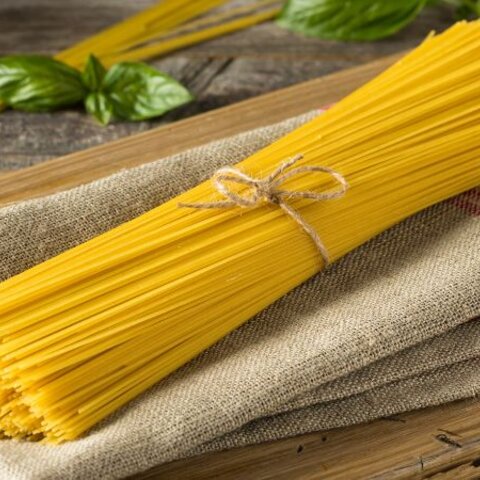
It's often reported the word "sandwich" originated with John Montagu, 4th Earl of Sandwich. The Earl supposedly ate bits of meat between pieces of bread so he could continue to play cards while eating and not get his hands greasy from the meat. Sandwiches continue to be a popular food today because of their versatility and convenience. Freezing sandwiches offers several additional benefits:
- Save money by making your own "fast food" sandwiches for a sack lunch or meal at home.
- Save time by making several sandwiches at once.
- Utilize "leftovers" or cook extra at a meal for use in tasty and different ways at future meals.
- Control the type of bread (such as choosing a whole grain bread), type of filling and spread (amount, salt, fat and so forth) by being in charge of the ingredients.
- Enjoy a wholesome, homemade sandwich as part of an inexpensive, quick meal!
Sandwich ingredients that DO and DO NOT freeze well
Some common sandwich fillings that DO freeze well include:
- Peanut butter and other nut butters
- Canned tuna and salmon
- Cooked roast beef, chicken and turkey (especially tasty when the meat is finely chopped and mixed with a "salad dressing," to add flavor and moistness.)
- Natural or processed hard and semi-hard cheeses, such as Swiss, Cheddar. NOTE: As frozen cheese may crumble more after thawing, you may be more satisfied with the result if you grate it before freezing it in sandwiches.
Some common sandwich fillings that DO NOT freeze well include:
- Hard-cooked egg whites (freezing toughens them).
- Jelly or jam (soaks into bread and makes it soggy).
- Tomatoes, lettuce, pickles, onions, etc. become limp when thawed; they can be added to thawed sandwiches just before eating them.
IMPORTANT: "Salad dressings," such as Miracle Whip, work better as a binder in sandwiches than mayonnaise. Mayonnaise tends to separate on thawing. So, experiment to see how you like the result before making a freezer full of sandwiches.
Basic steps in assembling, freezing and thawing sandwiches
The same basic steps may be followed for assembling most frozen sandwiches:
- For sandwiches where the filling might soak into the bread, spread a thin layer of soft butter or margarine to the edges of the sides of bread that will be the "insides" of the sandwich. DO NOT use melted margarine or butter. NOTE: Bread that is at least a day-old may be slightly firmer and easier to spread.
- Make your sandwiches "assembly line" fashion, completing one step for all sandwiches before moving on to the next step. Place them in zip-top/self-sealing type plastic sandwich bags, labeling the bag with the date and type of sandwich. Squish out as much air as possible before sealing them.
- Lay the sandwiches in a single layer in the freezer on a cookie sheet or other flat surface and freeze them for about an hour until they hold their shape. Then place the sandwich bags in a larger freezer-quality bag, such as a gallon freezer bag. Squish out extra air before sealing. The thin sandwich bags aren't satisfactory for maintaining food quality during longer-term freezer storage.
- Use frozen sandwiches within 1 to 3 months for best flavor and quality.
- Thaw individual sandwiches in their sandwich bag or other wrapping in the refrigerator. Transfer them to the refrigerator the day before you plan to eat them.
- To keep perishable sandwich foods like meats and cheeses cold, pack them in an insulated lunch bag or lunch box; include a small frozen gel pack. Or, if there's a refrigerator available, store perishable items there upon arrival.
- Add tomato or onion slices, lettuce, a squirt or dab or horseradish, pickles, etc. just before eating sandwiches. A small container or snack-size plastic bag of these add-ons can be packed with a sack lunch.
Frozen Sandwich Recipes
Frozen Beef, Chicken or Turkey Sandwich
The same basic recipe may be used for all these frozen meat sandwiches. Make extra roast beef, chicken or turkey or use leftovers of these foods for frozen sandwiches. Use the leftovers within a day or two of preparing the original food. Then add your own toppings, such as lettuce, condiments, etc. just before eating the sandwiches. Variation: Add some grated cheese to your meat/poultry mixture.
Ingredients for EACH sandwich:
- ¼ to ⅓ cup finely chopped cooked roast beef, chicken or turkey
- 2 to 3 teaspoons of "salad dressing"
- Soft butter or margarine (do not use melted form), about 2 teaspoons
- 2 slices bread
Directions:
- Mix beef, chicken or turkey with salad dressing.
- Spread a thin layer of soft butter or margarine to the edges of the sides of bread that will be the "insides" of the sandwich.
- Top one of each pair of bread slices with meat mixture; spread almost to the edges.
- Follow directions in previous section: "Basic steps in assembling, freezing and thawing sandwiches."
Frozen Peanut Butter and Jelly (or Honey) Sandwiches
Jelly and honey typically appear in a list of foods that don't freeze well in sandwiches. The reason: They soak into the bread and make it soggy. The trick to making this sandwich successful is spreading peanut butter on BOTH insides of the bread slices; then, spread jelly or honey in the middle so the peanut butter keeps it from soaking into the bread.
Ingredients for EACH sandwich:
- 2 slices bread
- 2 teaspoons peanut butter
- 1 teaspoon jelly or honey
Directions:
- Spread the inward-facing side of each slice bread slice with peanut butter.
- Spread jelly or honey on top of peanut butter on one of the bread slices. Cover with the other slice so the jelly/honey is between the peanut butter and won't soak into the bread.
- Follow directions in previous section: "Basic steps in assembling, freezing and thawing sandwiches."
Tuna or Salmon Salad Sandwiches
Use this basic recipe for your frozen tuna or salmon salad sandwiches. Then, just before serving the thawed sandwiches, pop in such additions as: tomato slices; pickle relish; lettuce; a slice of cheese; thin slice of your favorite onion; chopped red, green or yellow peppers or a few pepper rings; fresh basil leaves. NOTE: Check for water-packed versions of tuna or salmon prepared without added salt if you are limiting fat and/or sodium in your foods.
Ingredients for EACH sandwich:
- ½ to ⅓ of a 6-ounce can of tuna or salmon, drained
- 2 to 3 teaspoons "salad dressing"
- Soft butter or margarine (do not use melted form), about 2 teaspoons
- 2 slices bread
Directions:
- Mix tuna or salmon with salad dressing.
- Spread a thin layer of soft butter or margarine to the edges of the sides of bread that will be the "insides" of the sandwich. Top one of each pair of bread slices with tuna/salmon mixture; spread almost to the edges.
- Follow directions in previous section: "Basic steps in assembling, freezing and thawing sandwiches."
Frozen Cheese Sandwich (for grilling)
This is a great recipe for using up odds and ends of different cheeses!
Ingredients for EACH sandwich:
- 2 slices bread
- ¼ to ⅓ cup grated cheese (use natural or processed hard and semi-hard cheeses, such as Swiss, Cheddar, etc.)
- For grilling later: soft butter/margarine (do not use melted form), about 2 teaspoons
Directions:
- Top one of each pair of sandwich bread slices with grated cheese; spread almost to the edges.
- Follow directions in previous section: "Basic steps in assembling, freezing and thawing sandwiches."
- These sandwiches may be grilled directly from the frozen state. Simply spread the OUTSIDES of the sandwiches with a thin coating of butter or margarine.
- Grill in a double-sided grill until the cheese is melted and the outside of the sandwich is golden brown — about 4 to 5 minutes (check directions for your grill). Or, cook in a skillet on medium heat for 3 minutes per side or until cheese is melted and bread is golden brown.
*Reference to commercial products or trade names is made with the understanding that no discrimination is intended of those not mentioned and no endorsement by University of Nebraska–Lincoln Extension is implied for those mentioned.
Sources:
Freezing and Food Safety, United States Department of Agriculture (USDA), Food Safety and Inspection Service (FSIS)
How long does lunch meat stay fresh?, United States Department of Agriculture (USDA)
Freezing Prepared Foods, University of Georgia Extension
This article was originally written by Alice Henneman. It was reviewed and updated in 2022.
Tags:







